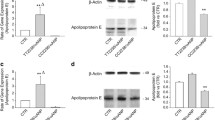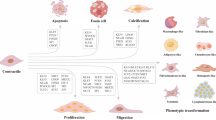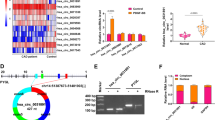Abstract
A low-frequency variant of sushi, von Willebrand factor type A, EGF, and pentraxin domain-containing protein 1 (SVEP1) is associated with the risk of coronary artery disease, as determined by a genome-wide association study. SVEP1 induces vascular smooth muscle cell proliferation and an inflammatory phenotype to promote atherosclerosis. In the present study, qRT‒PCR demonstrated that the mRNA expression of SVEP1 was significantly increased in atherosclerotic plaques compared to normal tissues. Bioinformatics revealed that EGR1 was a transcription factor for SVEP1. The results of the luciferase reporter assay, siRNA interference or overexpression assay, mutational analysis and ChIP confirmed that EGR1 positively regulated the transcriptional activity of SVEP1 by directly binding to its promoter. EGR1 promoted human coronary artery smooth muscle cell (HCASMC) proliferation and migration via SVEP1 in response to oxidized low-density lipoprotein (ox-LDL) treatment. Moreover, the expression level of EGR1 was increased in atherosclerotic plaques and showed a strong linear correlation with the expression of SVEP1. Our findings indicated that EGR1 binding to the promoter region drive SVEP1 transcription to promote HCASMC proliferation and migration.










Similar content being viewed by others

Data availability
The data in the current study are available. The WB images in Supporting Fig. 5 were uploaded.
References
Roth GA et al (2020) Global burden of cardiovascular diseases and risk factors, 1990–2019: update from the GBD 2019 study. J Am Coll Cardiol 76(25):2982–3021
Benjamin EJ et al (2019) Heart disease and stroke statistics-2019 update: a report from the American Heart Association. Circulation 139(10):e56–e528
Hansson GK (2005) Inflammation, atherosclerosis, and coronary artery disease. N Engl J Med 352(16):1685–1695
Libby P (2021) The changing landscape of atherosclerosis. Nature 592(7855):524–533
Arnett DK et al (2019) 2019 ACC/AHA guideline on the primary prevention of cardiovascular disease: a report of the American College of Cardiology/American Heart Association Task Force on clinical practice guidelines. Circulation 140(11):e596–e646
Pan H et al (2020) Single-cell genomics reveals a novel cell state during smooth muscle cell phenotypic switching and potential therapeutic targets for atherosclerosis in mouse and human. Circulation 142(21):2060–2075
Miano JM et al (2021) Fate and state of vascular smooth muscle cells in atherosclerosis. Circulation 143(21):2110–2116
Cao G et al (2022) How vascular smooth muscle cell phenotype switching contributes to vascular disease. Cell Commun Signal 20(1):180
Sato-Nishiuchi R et al (2012) Polydom/SVEP1 is a ligand for integrin α9β1. J Biol Chem 287(30):25615–25630
Myocardial infarction genetics and CARDIoGRAM exome consortia investigators, Stitziel NO et al (2016) Coding variation in ANGPTL4, LPL, and SVEP1 and the risk of coronary disease. N Engl J Med 374(12):1134–1144
Jung IH et al (2021) SVEP1 is a human coronary artery disease locus that promotes atherosclerosis. Sci Transl Med. 13(586):eabe0357
Winkler MJ et al (2020) Functional investigation of the coronary artery disease gene SVEP1. Basic Res Cardiol 115(6):67
Zhang H et al (2021) Augmenting ATG14 alleviates atherosclerosis and inhibits inflammation via promotion of autophagosome-lysosome fusion in macrophages. Autophagy 17(12):4218–4230
Ayari H et al (2013) Identification of two genes potentially associated in iron-heme homeostasis in human carotid plaque using microarray analysis. J Biosci 38(2):311–315
Grootaert MOJ et al (2021) Vascular smooth muscle cells in atherosclerosis: time for a reassessment. Cardiovasc Res 117(11):2326–2339
Tang HY et al (2022) Vascular smooth muscle cells phenotypic switching in cardiovascular diseases. Cells 11(24):4060
Wirka RC et al (2019) Atheroprotective roles of smooth muscle cell phenotypic modulation and the TCF21 disease gene as revealed by single-cell analysis. Nat Med 25(8):1280–1289
Kansakar U et al (2021) Targeting the phenotypic switch of vascular smooth muscle cells to tackle atherosclerosis. Atherosclerosis 324:117–120
Aherrahrou R et al (2020) Genetic regulation of atherosclerosis-relevant phenotypes in human vascular smooth muscle cells. Circ Res 127(12):1552–1565
Tcheandjieu C et al (2022) Large-scale genome-wide association study of coronary artery disease in genetically diverse populations. Nat Med 28(8):1679–1692
Solomon CU et al (2022) Effects of coronary artery disease-associated variants on vascular smooth muscle cells. Circulation 146(12):917–929
Finney AC et al (2017) Integrin signaling in atherosclerosis. Cell Mol Life Sci 74(12):2263–2282
Chen PY et al (2016) Smooth muscle FGF/TGFβ cross talk regulates atherosclerosis progression. EMBO Mol Med 8(7):712–728
Martos-Rodriguez CJ et al (2021) Fibrous caps in atherosclerosis form by notch-dependent mechanisms common to arterial media development. Arterioscler Thromb Vasc Biol 41(9):e427–e439
Peng X et al (2023) Role of the notch1 signaling pathway in ischemic heart disease (review). Int J Mol Med 51(3):27
Khachigian LM (2021) Early growth response-1, an integrative sensor in cardiovascular and inflammatory disease. J Am Heart Assoc 10(22):e023539
Xie Y et al (2023) Early growth response-1: key mediators of cell death and novel targets for cardiovascular disease therapy. Front Cardiovasc Med 10:1162662
Wang B et al (2010) Phosphorylation and acetylation of histone H3 and autoregulation by early growth response 1 mediate interleukin 1beta induction of early growth response 1 transcription. Arterioscler Thromb Vasc Biol 30(3):536–545
Fasolo F et al (2021) Long noncoding RNA MIAT controls advanced atherosclerotic lesion formation and plaque destabilization. Circulation 144(19):1567–1583
Yan SF et al (2006) Protein kinase C beta/early growth response-1 pathway: a key player in ischemia, atherosclerosis, and restenosis. J Am Coll Cardiol 48(9):A47–55
Andrassy M et al (2005) Centrol role of PKC beta in neointimal expansion triggered by acute arterial injury. Circ Res 96(4):476–483
Khachigian LM et al (1996) Egr-1-induced endothelial gene expression: a common theme in vascular injury. Science 271(5254):1427–1431
Li Y et al (2016) MicroRNA miR-191 targets the zinc finger transcription factor Egr-1 and suppresses intimal thickening after carotid injury. Int J Cardiol 212:299–302
Zhang J et al (2013) An Egr-1-specific DNAzyme regulates Egr-1 and proliferating cell nuclear antigen expression in rat vascular smooth muscle cells. Exp Ther Med 5(5):1371–1374
Han W et al (2010) EGR-1 decoy ODNs inhibit vascular smooth muscle cell proliferation and neointimal hperplasia of balloon-injured arteries in rat. Life Sci 86(7–8):234–243
Funding
This work was supported by grants from the National Natural Science Foundation of China (81970579 to GZP, 82101816 to QC, 82270068 to RJ) and the Natural Science Foundation of Jiangsu Province (BK20210965 to QC).
Author information
Authors and Affiliations
Contributions
Qiang Tian, Jia-He Chen, and Yi Ding wrote the main manuscript. Xin-Yu Wang, Jia-Yun Qiu and Li–Li Zhuang assisted in the methodology. Qian Cao, Rui Jin and Guo-Ping Zhou received funding for the study and led the study. All authors reviewed the manuscript.
Corresponding author
Ethics declarations
Competing interests
The authors declare no competing interests.
Ethical approval
The study was approved by the Clinical Research Ethics Committee of the First Affiliated Hospital of Nanjing Medical University (2016-SR-144). Informed consent was obtained from patients before participation.
Additional information
Publisher's Note
Springer Nature remains neutral with regard to jurisdictional claims in published maps and institutional affiliations.
Supplementary Information
Below is the link to the electronic supplementary material.
Rights and permissions
Springer Nature or its licensor (e.g. a society or other partner) holds exclusive rights to this article under a publishing agreement with the author(s) or other rightsholder(s); author self-archiving of the accepted manuscript version of this article is solely governed by the terms of such publishing agreement and applicable law.
About this article
Cite this article
Tian, Q., Chen, JH., Ding, Y. et al. EGR1 transcriptionally regulates SVEP1 to promote proliferation and migration in human coronary artery smooth muscle cells. Mol Biol Rep 51, 365 (2024). https://doi.org/10.1007/s11033-024-09322-x
Received:
Accepted:
Published:
DOI: https://doi.org/10.1007/s11033-024-09322-x



